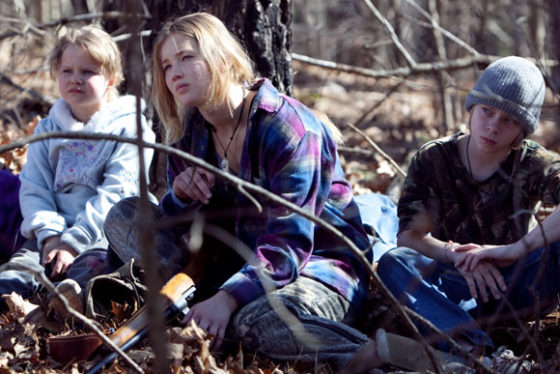Winter’s Bone

Ashlee Thompson as Ashlee, Jennifer Lawrence as Ree Dolly and Isaiah Stone as Sonny in WINTER’S BONE, directed by Debra Granik. Photo Credit: Sebastian Mlynarski
Adapted from Daniel Woodrell’s novel, Debra Granik’s Winter’s Bone is the modern western. In the rural Ozarks of Missouri, 17-year old Ree Dolly (Jennifer Lawrence) looks after a mentally-ill mother, and two younger siblings—their shelter, care and feeding entirely on her shoulders. This precarious balance is upset when a Sheriff (Garrett Dillahunt) informs Ree that her father, arrested for cooking crystal meth, skips out on bond—secured by the family’s assets, which she’ll lose if he fails to make his court appearance.
In the tightly-knit community, her friend, Gail (Lauren Sweetster) and neighbor, Sonya (Shelly Waggener) seem to be the only ones looking out for her—save for the Sheriff. In her effort to track down her estranged father, she finds herself at loggerheads with two patriarchs—the leathery, burly Thump Milton (Ron “Stray Dog” Hall) and her uncle, the lanky, hardened Teardrop (John Hawkes)—so nicknamed for the tattoo indicating he’s murdered someone. “You always have scared me,” says Ree to Teardrop. “That’s ’cause you’re smart,” he answers. The women are worse. One orchestrates a brutal beating, the kind you might read about in gang initiations.
Having grown up in North Dakota, scenes of parenting classes for teens and the omnipresence of military recruiters–two of the most common options for youths in remote, rural America—are all too familiar to me. “Closely-knit” doesn’t begin to describe such communities. If you talk about someone, within a day or two everyone knows. Flout the unwritten social customs of the community, and you might as well pack up and leave. Unfortunately, Ree can’t afford to run away to anywhere—except perhaps the Army, which for many youths under the poverty line is the only path out of the rut. It becomes clear from this juxtaposition of elements, the struggle to retain a cultural identity in defiance of a world that has otherwise moved into the twenty-first century without objection, that Ms. Granik’s film is a contemporary western or, as Mr. Woodrell calls it, country noir. It’s all too easy to characterize these individuals as sociopathic hicks, but that would be failing to see the obverse. In a comfortable, urban life, most of us are far removed from a daily struggle for basic survival. Living in a homeless shelter would be a step up for Ree and her siblings.
Jennifer Lawrence plays Ree’s mature sensibilities without hammering on them. “Want some peanut butter?” she asks the kids. Her little brother retorts, “Where did you find peanut butter.” She shows them the fundamentals of survival: Hunting, skinning and cooking everything from squirrel to deer. “Do we eat the guts,” says brother. “Not yet,” says Ree. She exudes determination without boisterously overplaying her hand. By contrast, Dale Dickey as the abrasive Merab is delightfully trashy—resembling a haggard, Southern witch. Merab and her two female cohorts are vaguely analogue to the three witches in Hamlet or, more recently, Clash of the Titans. They seem malevolent, but even in a community this ass-backward, there must be an order to things, or no one would survive long enough to procreate.
Though it appears as if everyone in the town behaves like an outlaw, there is a balance. Consider a scene in which Ree visits her father’s ex-wife’s home. Friends are gathered in the living room. A plain, elderly woman sings in a somber tone. Behind the group, on a shelf is a picture of a young man in military uniform. Without expository dialogue, the director reveals in one shot, another side of these people and their escapes from the toils of Ozark life.
I’ve said that great films make one re-think their opinions or politics. Such was the case with the 2005 Academy Award® winner for Best Adapted Screenplay, Brokeback Mountain. While neither can I say if Winter’s Bone will become quite the same kind of cultural phenomenon, nor has it made me re-evaluate my left-of-center politics, it does force me to look at rural living as more nuanced than just ignorance. Ignorance worth criticizing is that which exists among otherwise knowledgeable people who have readily-available alternatives to their mindset.
Ms. Granik’s film has both the most admirable protagonists and most enigmatic, paradoxical antagonists I’ve seen thus far this year. The cinematography, under the direction of Michael McDonough, is a grainy combination of yellows, browns, greens and greys which evoke both the faded image of worn photographs, decades old, and the cold, bleak winter climate of a mountain range. Possessed with a depth of narrative largely absent from mainstream pictures for more than twenty years, Winter’s Bone easily rounds out the best of the films I’ve covered at the Dallas International Film Festival.
 Winter’s Bone • Dolby® Digital surround sound in select theatres • Aspect Ratio: 1.85:1 • Running Time: 100 minutes • MPAA Rating: R for some drug material, language and violent content. • Distributed by Roadside Attractions
Winter’s Bone • Dolby® Digital surround sound in select theatres • Aspect Ratio: 1.85:1 • Running Time: 100 minutes • MPAA Rating: R for some drug material, language and violent content. • Distributed by Roadside Attractions